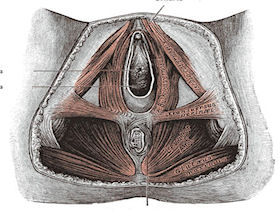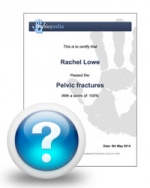Pelvic Floor Impact Questionnaire (PFIQ - 7)
Original Editor - Kirsten Ryan
Top Contributors - Kirsten Ryan, Michelle Walsh, Admin, Tony Lowe, Laura Ritchie, Kim Jackson, WikiSysop, Nicole Hills, Evan Thomas, Scott Buxton and Oyemi Sillo
Objective[edit | edit source]
The Pelvic Floor Impact Questionnaire-7 (PFIQ-7) is a shortened, less comprehensive version of the Pelvic Floor Impact Questionnaire (PFIQ).[1] It was created by Barber and colleagues (2004)[1] to save time, yet remain effective, in clinical and research encounters. It is a health-related quality of life questionnaire that is specific for women with pelvic floor conditions.[1] It includes scales from the Urinary Impact Questionnaire (UIQ-7), Pelvic Organ Prolapse Impact Questionnaire (POPIQ-7), and the Colorectal-Anal Impact Questionnaire-7 (CRAIQ-7),[1] which are short-forms of their the longer versions. It is useful to determine changes in symptom-severity over time and before and after treatments.[1]
Intended Population[edit | edit source]
Women over the age of 18 with pelvic floor conditions including urinary incontinence, pelvic organ prolapse, and fecal incontinence.[1]
Method of Use[edit | edit source]
The PFIQ-7 consists of 7 questions that need to be answered 3 times each (corresponds to the scales previously mentioned) considering symptoms related to the bladder or urine, vagina or pelvis, and bowel or rectum and their effect on function, social health, and mental health in the past 3 months.[1] The responses for each question range from "not at all," which is a 0, to "quite a bit," which is a 4.[1] The mean of each of the 3 scales is individually calculated (add scores, divide by 7, and then multiply by 100).[1] These means are then added together, divided by 3, and then multiplied by 100 to get the total PFIQ-7 score, which ranges from 0-300. A lower score means there is a lesser effect on quality of life.[1]
Evidence[edit | edit source]
Correlation[edit | edit source]
Correlation, represented by r, ranges from -1.0 to +1.0. If the r value is 0 that means there is no correlation. If the r value is close to -1.0 that means that both values will decrease linearly. If the r value is close to +1.0 that means that both values will increase linearly.
Correlation of the short-form versions with the long-form versions:[1]
Reliability[edit | edit source]
The test-retest reliability, represented by intraclass correlation coefficients (ICC):[1]
Validity[edit | edit source]
The PFIQ-7 demonstrates construct validity as it demonstrates a significant association with appropriate measures of symptom severity and pelvic floor diagnoses.[1]
Responsiveness[edit | edit source]
The PFIQ-7 has shown moderate responsiveness between the pre- and post-operative periods for pelvic and continence surgeries.[1] The standardized response mean (SRM) for all the sub scales fell within the range of 0.5 to 0.7.[1] It showed an effect size of 0.67 and a SRM of 0.63.[1] However, the responsiveness has been shown to be vary amongst different patients.[2] The highest SRMs have been found in the UIQ-7 and the CRAIQ-7 and the lowest SRMs have been found in the POPIQ-7.[2] However, the SRM for the POPIQ-7 increased at 3 and 12 months in patients who underwent surgery for pelvic organ prolapse.[2]
Miscellaneous[edit | edit source]
The PFIQ-7 demonstrated a statistically significant improvement at 3 to 6 months after surgery, but the responsiveness was somewhat less than the PFDI-20.
One of the strengths of the PFIQ-7 is that it give a comprehensive assessment of the effect of pelvic floor disorders on the quality of life of women, rather than only assessing one aspect of pelvic floor function such as urinary incontinence. Its relative length makes it easy to use in both clinical and research settings.
Further studies are needed to determine the between-treatment MCID (clinically meaningful change in quality of life[3]) and the MCID of the individual scales.[1]
Links[edit | edit source]
Pelvic Floor Impact Questionnaire (PFIQ-7) on the Rehabilitation Measures Database
Paper by Barber et al 2005 describing the development of the PFIQ-7
Read 4 Credit[edit | edit source]
|
Would you like to earn certification to prove your knowledge on this topic? All you need to do is pass the quiz relating to this page in the Physiopedia member area. |
References[edit | edit source]
- ↑ 1.00 1.01 1.02 1.03 1.04 1.05 1.06 1.07 1.08 1.09 1.10 1.11 1.12 1.13 1.14 1.15 1.16 1.17 1.18 1.19 1.20 1.21 1.22 1.23 Barber MD, Walters MD, Bump RC. Short forms of two condition-specific quality-of-life questionnaires for women with pelvic floor disorders (PFDI-20 and PFIQ-7). American journal of obstetrics and gynecology. 2005 Jul 1;193(1):103-13.
- ↑ 2.0 2.1 2.2 Barber MD, Chen Z, Lukacz E, Markland A, Wai C, Brubaker L, Nygaard I, Weidner A, Janz NK, Spino C. Further validation of the short form versions of the Pelvic Floor Distress Inventory (PFDI) and Pelvic Floor Impact Questionnaire (PFIQ). Neurourology and urodynamics. 2011 Apr;30(4):541-6.
- ↑ Crosby RD, Kolotkin RL, Rhys Williams G. Defining clinicallyfckLRmeaningful change in health-related quality of life. J ClinfckLREpidemiol 2003;56:395-407








